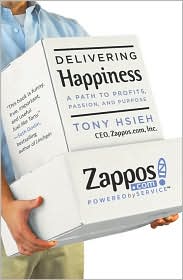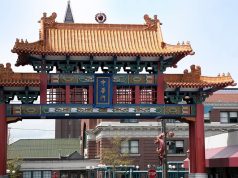by Larry Sivitz
When King County’s king of E-tailing, Amazon.com, announced they were purchasing the legendary online shoe and apparel company known as Zappos in 2009 for upwards of $928 million, the Amazonians declared they would not disturb one stone in the rock garden of the Las Vegas-based company’s inspired corporate quarry. There was a profound reason for the hands-off attitude. Zappos culture rocks!
In the A-to-Z glossary of business, from Amazon to Zappos, the shoe supersite belonged in the panetheon of E-commerce. Zappos’ standards have earned it the reputation of being the MOST consumer-centric E-tailer in all of cyberspace — including Amazon. And that culture applied not simply outwardly to its customers who had come to admire, even worship, the company as a merchant they could trust with their hearts and their feet, but to the company’s own employees. In the Northwest, such a customer-centered focus was historically linked to the shoe sales policies of Nordstrom, whose “customer is king” policy is also legion in the retail space. But Zappos’ core values transcended even the behemoths of customer benefits by creating a culture of service where genuine employee happiness is not only nurtured, but cultivated.
In Delivering Happiness, Zappos CEO Tony Hsieh (pronounced Shay) traces the evolution and elocution of that culture while separating material facts from myth. (Zappos filed a lawsuit against the Disney organization challenging that it could not actually prove that it was the “Happiest” Place on Earth.”) Zappos can!
Like Delivering Happiness, the Zappos organization is an open book when it comes to placing its core values out in broad daylight. For example, you can read them here <http://about.zappos.com/our-unique-culture/zappos-core-values>. The annual testament of the culture can also be found each year in the Zappos Culture Book, a hard bound volume that looks and feels like a high school or collegeyearbook, recognizing individual employees for their uniqueness both as employees and as people.
An excerpt: “At Zappos, Anything Worth Doing Is Worth Doing With WOW.” WOW is such a short, simple word, but it really encompasses a lot of things. To WOW, you must differentiate yourself, which means doing something a little unconventional and innovative. You must do something that’s above and beyond what’s expected. And whatever you do must have an emotional impact on the receiver. We are not an average company, our service is not average, and we don’t want our people to be average. We expect every employee to deliver WOW. Whether internally with co-workers or externally with our customers and partners, delivering WOW results in word of mouth. Our philosophy at Zappos is to WOW with service and experience, not with anything that relates directly to monetary compensation (for example, we don’t offer blanket discounts or promotions to customers). We seek to WOW our customers, our co-workers, our vendors, our partners, and in the long run, our investors.”
CEO Hsieh was the first born child of an Asian American couple who emigrated from Taiwan, to California’s Bay Area. Hsieh’s parents endorsed education; and Hsieh obliged by earning good grades in school. He also displayed an inherent entrepreneurial spirit. All eight colleges he applied to granted him admission. He chose Harvard to appease his parent’s. Once there, he scheduled his classes based on convenient timing vs. academic interest. Courses met on Mon/Wed/Friday and ended by 1 pm; leaving his Tuesdays and Thursdays free. He habitually slept in and rationalized missing class. He ate ramen noodles and watched soap operas throughout his first year of college.
Hsieh worked as a computer programmer after graduation making $40,000 a year. Initially allured by the salary, he soon found himself bored and unfulfilled. Employed five months; he quit. Concurrently, the World Wide Web was emerging as a major force. He and a college friend devised LinkExchange. It was a simple way for Web sites with limited budgets to gain increased exposure via banner ads. Their invention skyrocketed, soon drawing the attention of buyers. Hsieh declined to sell LinkExchange, that is, until Microsoft offered $265 million. The deal was a lesson in human behavior and character for Hsieh. “Large amounts of money have a strange way of getting people’s true colors to come out,” he says.
Free time lured Hsieh to Las Vegas to parlay his mathematical prowess into poker success. It wasn’t about the money, but the challenge of figuring out how to beat the game. Poker taught him the discipline of not confusing the right decision with the individual outcome of any single hand- a philosophy that works well in business too. Hsieh shares those tenets in the book. They include “Differentiate yourself. Do the opposite of what the rest of the table is doing,” and, “Be nice and make friends. It’s a small community.” Hsieh’s biggest lesson learned was knowing what table to sit at and when to change tables. “Changing tables” can also be a metaphor for life, as we always have the power to change our direction. Although, Hsieh admits, psychologically, it can be hard because of the all the inertia to overcome. “Without conscious and deliberate effort, inertia always wins,” says Hsieh.
Microsoft’s purchase of Link Exchange meant that Tony wouldn’t ever need to work again in his life, and if he stayed at Microsoft for at least one year following the purchase, he could make even more money.
“If I stayed the entire time [12 months], then I would walk away with close to $40 million. If I didn’t, then I would have to give up about 20 percent of that amount … A few days later, I went to the office, sent my gbood-by e-mail to the company, and walked out the door. I didn’t know exactly what I was going to do, but I knew what I wasn’t going to do. I wasn’t going to sit around letting my life and the world pass me by. People thought I was crazy for giving up all that money. And yes, making that decision was scary, but in a good way.”
“I didn’t realize it at the time, but it was a turning point for me in my life. I had decided to stop chasing the money, and start chasing the passion.”
The story of how Tony became involved with Zappos is fascinating.
A new development with lofts was being built in the heart of San Francisco. Hsieh and friends all purchased space and began to build their own community. They also started an investment fund to cultivate new businesses. Initially, $27 million was available. One company was a generic online shoe store (later renamed Zappos-a derivative of the Spanish word zapato which means shoe). Hsieh was confident that venture capitalists would be interested in investing in the site. He was wrong. They questioned its long-term profitability.
What is stunning are the revelations about the personal sacrifices Tony was forced to make early in Zappo’s history (circa 2000). When Zappos was on the brink of failure and needed $2 million dollars to pivot and pursue a slightly different strategy, Tony made an important decision:
My plan was to take almost everything that I had left in my name and liquidate it in a fire sale. I would bet the farm and put all the proceeds into Zappos. To an outsider, it may have seemed like a desparate and reckless plan.
It certainly was desperate, but the end result made it worthwhile. Zappos has delivered much happiness to the company’s CEO, to its employees, and to Zappos’ may satisfied customers. That is the final metric in Tony Hsieh’s incredible adventure. [24×7]

















